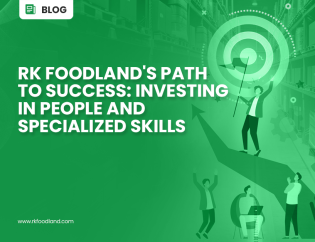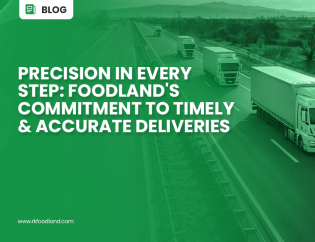
[Avg. Read Time < 5 mins]
Navigating the intricacies of food supply chain is a complex task. It requires businesses in the Food Service and FMCG sectors to grapple with various challenges such as seasonal variability, regulatory compliance, inventory management, cold chain logistics, and the impact of weather & natural disasters, among others. Approximately 33% of all food, and 45% of fresh produce, is lost or wasted before reaching consumers. These complexities demand strategic sourcing and procurement, meticulous assurance processes, demand planning and forecasting, a technically competent workforce, and adherence to standard operating procedures. This blog explores these complexities, presents relevant examples, and proposes compelling solutions. Further, it highlights the necessity of aligning people, processes, and technology, leveraging partnerships, fostering a culture of continuous improvement. As we journey through these concepts, we highlight how businesses can transform these challenges into opportunities, ultimately leading to resilience and growth in the face of a dynamically changing food supply chain landscape.
Understanding What Makes the Food Supply Chain Complex
Food supply chain is a maze of interconnected processes, each with its unique challenges and complexities. At the heart of these complexities lies the dynamic nature of demand. Consumer preferences are ever-changing, influenced by factors such as health trends, cultural shifts, and seasonal variations. These fluctuations necessitate a supply chain that is agile and responsive, capable of adjusting to the dynamic demand.
- Quality and safety are paramount in food supply chain. Ensuring that perishable goods maintain their freshness and are safe for consumption requires meticulous temperature control and shelf-life management. This becomes even more challenging when considering the increasing competition in the food industry. As businesses strive to differentiate themselves, they often venture into new geographies and channels, each with its unique logistical challenges.
- The infrastructure supporting the food supply chain, particularly cold storage, is often inefficient and ineffective. This is especially true in developing regions where the lack of adequate facilities can lead to significant food waste. Furthermore, limited traceability and visibility across the supply chain can worsen these issues, leading to inefficiencies and potential safety risks.
- Regulatory compliance adds another layer of complexity. Food businesses must navigate a maze of regulations that vary from region to region. These regulations cover everything from food safety standards to packaging requirements, and non-compliance can result in hefty fines or even business closure.
- Environmental, social, and governance (ESG) concerns are increasingly influencing the food supply chain. Consumers and regulators alike are demanding more sustainable and ethical practices, pushing businesses to scrutinize every aspect of their supply chain, from sourcing to waste management.
- Lastly, weather and seasonal variations can significantly impact the food supply chain. Unpredictable weather patterns can disrupt crop yields, while seasonal variations can lead to spikes in demand for certain products. These factors necessitate a supply chain that is not only robust but also adaptable to change.
In conclusion, the complexities of the food supply chain are multifaceted and interwoven. Managing these complexities requires a holistic approach that combines technology, strategic planning, and stringent quality and process controls. By understanding these complexities, businesses can better navigate the challenges of the food supply chain, ultimately enhancing safety, efficiency, and growth.
Developing Solutions for Challenges in the Food Supply Chain
In the ever-evolving business landscape, the ability to navigate the complexities of the food supply chain is not just a necessity but a strategic advantage. The challenges associated with perishable food supply chains, such as temperature control, shelf-life management, and handling of returns and rejections, are inherent to the food industry. However, these complexities are not obstacles but opportunities for businesses to demonstrate their resilience and adaptability.
1.Seasonal Variability and Weather/ Natural Disasters in FMCG
An unexpected rough weather disrupts the tomato supply of an FMCG soup producer, causing higher costs and production delays.
Solution: The company could build stronger relationships with a diversified group of suppliers from different geographical regions. Utilizing predictive analytics and AI, they can better forecast potential weather-related disruptions and adjust their sourcing strategies accordingly.
2. Regulatory Compliance and Traceability/ Transparency in Food Service
A restaurant chain sourcing organic ingredients faces new stringent regulations requiring comprehensive supply chain documentation.
Solution: Implementing a blockchain-based supply chain management system provides a decentralized, immutable record of all transactions, enhancing traceability and transparency. This not only aids regulatory compliance but also reinforces customer trust in their organic sourcing claim.
3. Inventory Management and Complex Distribution Networks in FMCG
An international ice cream manufacturer struggles with inventory management due to varying demand patterns and a complex distribution network.
Solution: A solution could be the adoption of advanced inventory management systems powered by machine learning. These systems can predict demand patterns, optimize stock levels, and streamline distribution strategies, thus effectively managing the inventory across all regions.
4. Cold Chain Logistics, Quality Control, and Environmental Impact in Food Service
A seafood restaurant in a landlocked city struggles with maintaining seafood freshness, rigorous quality control, and environmental responsibility due to daily long-distance transportation.
Solution: The restaurant could invest in state-of-the-art cold chain technologies that are energy-efficient, reducing their environmental footprint. They can also partner with a certified quality control agency to ensure freshness. Additionally, exploring locally available, sustainable seafood options could help reduce their dependency on long-distance shipments.
Implementing such effective solutions to tackle food supply chain complexities requires a robust foundation of strategic sourcing and procurement practices, and the deployment of advanced demand planning and forecasting models. These strategies enable businesses to anticipate market shifts, mitigate supply risks, and ensure a consistent supply of high-quality products. Meanwhile, meticulous assurance processes backed by stringent quality measures are indispensable for maintaining product integrity and complying with regulatory standards. However, these processes and technologies are only as good as the people who manage them. Thus, it’s essential to have an experienced and technically skilled workforce, who can adhere to Standard Operating Procedures and drive operational excellence. Embracing these elements not only simplifies the inherent complexities but also fortifies the food businesses against future challenges, paving the way for sustainable growth.
Implementing Strategies to Simplify Complexities in the Food Supply Chain Together
This calls for a unified approach where strategic synergy, collaborative capabilities, and progressive excellence form the cornerstones of success. Strategic synergy entails the alignment of people, processes, and technology, backed by effective execution, routine reviews, and transparent reporting, all steering towards a common strategic goal. Moreover, businesses can bolster their supply chain by leveraging collaborative capabilities, fostering partnerships to share services and capabilities that augment their existing resources. It’s equally vital to cultivate a culture of progressive excellence that encourages continuous improvement across all supply chain elements, leading to efficiency, resilience, and sustainability. While some leading food businesses have mastered these strategies, others have found value in collaborative approaches, overcoming supply chain complexities through supply chain partnerships. Together, these strategies provide a blueprint for simplifying complexities and achieving a robust, responsive, and resilient food supply chain.
As food businesses operate in an increasingly complex supply chain landscape, they need strategic and effective solutions to navigate the challenges. Aligning people, processes, and technology, leveraging partnerships, and fostering a culture of continuous improvement can significantly simplify these complexities. RK Foodland, through its Managed Services, stands ready to partner with you on this journey. With solutions tailored specifically for food businesses, helping you maintain quality, comply with regulations, manage inventories, and sustain in face of weather anomalies and natural disasters, build a resilient and effective supply chain.
Connect with our experts and explore how we can together build a supply chain capable of thriving in any environment.
Related Content | Foodland’s Resources
The Importance of Supply Chain Visibility for Perishable Foods
Roles of Technology in Improving Perishable Food Supply Chains
Tips for an efficient perishable goods supply chain









